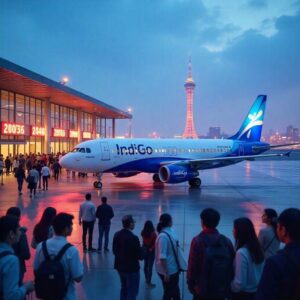On October 26 2025, IndiGo launched the daily non-stop service between Kolkata (Netaji Subhas Chandra Bose International Airport) and Guangzhou (Guangzhou Baiyun International Airport), restoring direct flights between India and China after more than five years.
The ribbons cut on the runway echo something larger: the thaw in travel, commerce and cultural exchange between two of Asia’s largest populations.
Why flights stopped and why this matters now

In early 2020, direct commercial flights between India and China came to a halt. First grounded by the global pandemic, then held back by mounting border tensions along the Himalayan frontier.
The absence of a direct air link meant higher travel costs, longer layovers, and less-efficient cargo logistics. With the revival of this corridor, the practical friction erodes, and with it opens new doors.
What changes for travel, tourism and people-to-people links

For Indian outbound travellers
For Indians heading to China, the game has changed. Direct flights mean shorter journeys, fewer transfers and a richer palette of destination possibilities. Whether you’re trekking in Yunnan, shopping in Shanghai, or exploring historical Sichuan, the path just got more accessible.
For Chinese outbound travellers
For Chinese travellers visiting India, this route signals that India is back in the mix as a direct-access destination. Eastern India via Kolkata, rich in heritage, cuisine and cultural cross-pollination, can become a fresh draw.
For Chinese inbound visitors
China sends millions of travellers abroad each year. Make entry simple and the journey short and India moves from a detour to a desired destination. Tourist brands, hospitality chains and regional experiences now have a clearer runway for Chinese guests.
For Indian export-brands and business travellers
From a logistics perspective the direct air link helps. Faster cargo transit, fewer transits through third-country hubs, streamlined business travel – these reduce time and cost. For Indian manufacturers, exporters and service providers who look to China (and vice versa), this is a facilitator.
Trade, business and economic ripple effects

Direct flights do more than move people, they move ideas, goods and value. The reopening of air connectivity is a tailwind for:
- Export-oriented brands in India: Especially those in eastern India (West Bengal, Odisha, Assam). They now have a more direct route to a major Chinese manufacturing and consumption zone.
- Chinese inbound investment and sourcing: Producers in China may look at east India as a gateway, and Indian firms can more easily negotiate and visit Chinese partners.
- Tourism supply-chain industries: Hotels, tour operators, transport services, language specialists – all benefit when travellers come in larger numbers and more often.
- Edtech and education: Exchange programmes and student mobility that were hampered by longer travel routes and layovers or visa uncertainty might now ramp up.
From the diplomatic commentary: the Indian government described it as a boost to “people-to‐people contact” and gradual normalisation of exchanges.
What to watch next: opportunities and caution

Opportunities
- Additional routes: For example, the planned service between Delhi and Shanghai via China Eastern Airlines (starting November) reflects a broader roll-out.
- MICE (meetings-incentives-conferences-events) potential: Businesses can assemble delegates from both countries more easily.
- Marketing campaigns: Travel brands, hotel chains, export companies and edtech firms can lean on the “direct link revived” message in all geographies.
Caution
- Visa regimes and regulatory hurdles still exist. Air connectivity is one piece; access policies may not keep pace.
- Geopolitical/spill-over risk: Tensions between the two nations still linger; connectivity is a step forward but not a full normalization yet.
- Infrastructure and service readiness: As traffic picks up, airports, hotels and ancillary services must scale. Eastern India’s airports for instance need to handle heavier international traffic.
What this means for brands and marketers

- Travel & tourism brands: Use the headline “India-China direct flights resume” as a hook to attract curious outbound travellers. Feature bilingual campaigns (Chinese + English or Hindi) emphasising directness, convenience and destination novelty.
- Export/manufacturing brands: Communicate improved connectivity to prospective Chinese partners or supply-chain stakeholders. Use case studies of reduced transit time or direct meeting capability.
- Education/edtech brands: Highlight bilateral student mobility, cultural exchange programmes and gateway access between India and China. Showcase the “less friction, more possibility” narrative.
- Regional brands in eastern India: This route gives you a story: “Your gateway to China opens from Kolkata”. Local tourism boards, hospitality ventures, local exporters can use this to position themselves.
Campaign ideas:
- “Fly direct, connect faster – Kolkata → Guangzhou” (for Indian outbound & Chinese inbound)
- “Export made direct: India-China route re-opens, streamline your supply chain” (for export brands)
- “Study, work, explore – Indo-China link revived” (for education/edtech)
Quick facts at a glance

- Route: Kolkata (CCU) → Guangzhou (CAN) via IndiGo daily non-stop service starting Oct 26 2025.
- First flight carried approx. 176 passengers.
Beyond the already operational Kolkata–Guangzhou service, several new direct routes between Indian and Chinese cities have been announced by airlines. Key routes include:
- New Delhi – Shanghai (China Eastern Airlines) – Starting Nov 9, 2025
- New Delhi – Guangzhou (IndiGo) – Starting Nov 10, 2025.
Make the India-China Corridor Work for You
The corridor is open, the skies are clear, and the groundwork for renewed exchange is firmly in place. Whether you’re planning your next campaign, your next shipment, or your next journey, now is the time to act.
Routes have reopened. Policies are shifting. Possibilities are expanding. From tourism to trade, from classrooms to boardrooms – this isn’t just a resumption of flights. It’s a relaunch of opportunity. Make sure you’re on board.






















